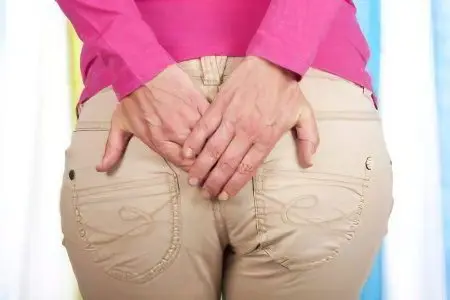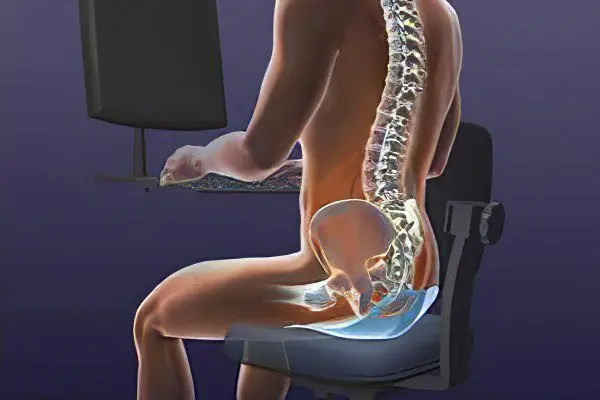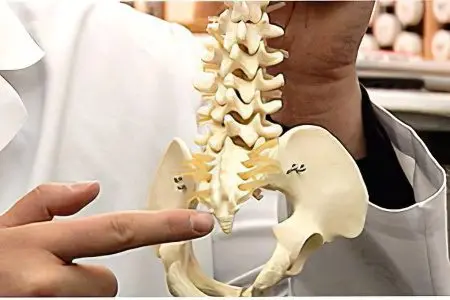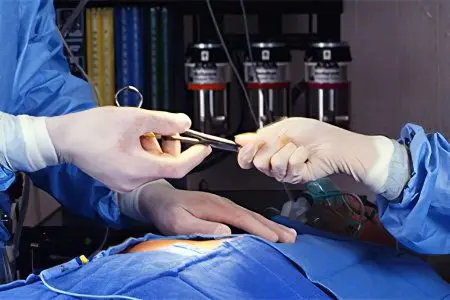Contents

As a result of inflammation of the coccygeal canal, a fistula, or coccygeal cyst, is formed. This disease mainly affects young men. It was first described during the Second World War, when, due to the lack of hygienic conditions, frequent injuries of the sacral spine, the fistula on the coccyx began to occur very often.
Currently, the coccygeal fistula occurs in men who lead a sedentary lifestyle, when normal blood circulation is disturbed in the lower spine.
The coccygeal fistula appears in a narrow tubular canal called the epithelial coccygeal tract. The coccygeal tract is a congenital pathology of the sacral spine, also called the dermoid cyst of the coccyx or the pilonidal sinus.
The epithelial coccygeal passage opens at the top of the intergluteal fold and looks like one or more small openings. It is lined by the epithelium, and during puberty, intensive hair growth begins in this channel. The other end of the coccygeal passage opens into the subcutaneous tissue, it is not connected with the coccyx and the sacrum.
If the openings of the coccygeal passage become clogged, the content stagnates inside it. Pathogenic bacteria multiply intensively, and pus forms inside the coccygeal passage. Under its influence, the walls of the epithelial passage are melted, pus enters the subcutaneous fatty tissue. An abscess can open anywhere in the skin of the anal area, then a fistula is formed.
Causes of the coccygeal fistula

The epithelial coccygeal passage is formed more often in the male fetus at 5-6 weeks of fetal development, when such a rudiment as a small tail, for some reason, did not undergo transformation into the usual form of the sacral spine.
Until puberty, this congenital pathology almost never makes itself felt. During adolescence, increased hair growth begins, intense secretion of sebum. In combination with hygiene disorders, a decrease in the body’s immune reactivity, the contents of the epithelial passage become infected and inflamed.
The lower spine is a rather vulnerable area of the human body, because it is riddled with nerve endings and any injury or pathology of the coccyx causes severe pain and is fraught with complications.
Additional causes of inflammation of the epithelial coccygeal passage:
hypothermia;
Prolonged physical overload;
Sedentary lifestyle;
Violations of calcium metabolism (its excess or lack);
Nerve entrapment;
Injury.
Pilonidal fistula is a great danger to the body. Its course is difficult to predict, moreover, the risk of eczema, abscess and phlegmon (inflammation of the subcutaneous fatty tissue) increases.
Symptoms of a Pilonidal Fistula

The fact that there is such a congenital pathology as an epithelial coccygeal passage, a person may not even guess until an infectious process begins to develop in him.
Sometimes the following symptoms may appear:
Itching
Unpleasant sensations when changing posture, when walking and during prolonged sitting;
Excessive hydration of the skin by products of excretion from the epithelial passage.
When the inflammatory process develops and an abscess forms, the pain becomes unbearable. They are not stopped even by strong analgesics, the patient from pain cannot find a place for himself.
After spontaneous opening of an abscess in a patient who did not seek medical help, intense pain subsides, but the focus of inflammation persists, and the disease becomes chronic. A coccygeal fistula is formed, connecting the abscess to the skin. Relapses will not take long, suppuration will soon form again, capturing an increasing area. As a result, intoxication of the body occurs.
Her symptoms:
Temperature reaching critical values (+40,5°C);
Weakness;
Headache;
Increased fatigue;
Sleep and appetite disorders.
Diagnosis and differential diagnosis

Most often, a visual examination of the patient by a surgeon or dermatologist is sufficient to determine the diagnosis. The inflamed holes in the intergluteal fold are clearly visible, as well as the hole of the coccygeal fistula with purulent discharge. The main task of the doctor is to differentiate the coccygeal fistula from diseases similar in symptoms.
For this, diagnostic methods are used:
Rectal examination with palpation of the coccyx and vertebrae of the sacrum;
Sigmoidoscopy – exclusion of pathologies of the rectum;
Colonoscopy – exclusion of diseases of the lower intestine;
Fistulography is an x-ray examination of the rectum using a contrast agent.
In most cases, a digital examination of the anus or only a visual examination is sufficient. Additionally, laboratory tests are prescribed – a general blood and urine test, a biochemical blood test, and a fecal occult blood test.
Diseases from which the coccygeal fistula should be distinguished:
fistula of the rectum – goes not to the coccyx, but to the rectum, has access to the crypt;
osteomyelitis of the coccyx – there is pathological mobility of the vertebrae;
epidermoid cyst – does not have a primary opening;
presacral teratoma – palpated as a dense tumor.
Pilonidal fistula treatment

The only method of treating a coccygeal fistula is the removal of an inflamed epithelial coccygeal passage in a hospital setting. No conservative methods will help to achieve recovery. Self-treatment with lotions and baths will only worsen the patient’s condition and prolong the duration of treatment.
During the operation, the surgeon removes the coccygeal fistula along with the affected surrounding tissues. It is better if the operation takes place in a specialized department of proctology, whose specialists have extensive practical experience in treating without relapses.
Methods of carrying out the operation to remove the coccygeal fistula:
With an open wound – removal of the fistula with the creation of natural drainage, has a high efficiency, a minimum of relapses, despite the long rehabilitation period;
With a closed wound – excision of the coccyx fistula with the creation of artificial drainage, is used during remission, has a risk of relapse;
Removal of the coccygeal fistula towards the secondary subcutaneous opening through which the wound is drained;
The method of karidakis and basque – removal of the coccygeal fistula along with nearby affected tissues, has a minimum of relapses and a short rehabilitation period.
The incision is made along the intergluteal fold, so the seam will practically not be noticeable. The doctor removes all the affected areas of the subcutaneous tissue, sutures the surgical wound. In the first 4-5 days after the operation, the patient is recommended bed rest. The sutures are removed only after 2 weeks, sitting on a chair and carrying heavy weights is prohibited for 3-4 weeks after the operation.
During rehabilitation, it is recommended to wear loose cotton underwear, shave off the hair around the wound, and observe thorough hygiene of the anal area.
Prognosis of the disease
Radical removal of the coccygeal fistula leads to complete recovery. Until the wound heals, the doctor observes the patient.
If the operation is postponed, purulent inflammation spreads to the tissue, new abscesses, coccygeal fistulas are formed, which find exits in the groin and perineum. Pyoderma (purulent skin lesions) and actinomycosis (fungal infection of the skin and internal organs) join the underlying disease. Subsequent treatment takes a long time, the operation captures a much larger amount of tissue.









